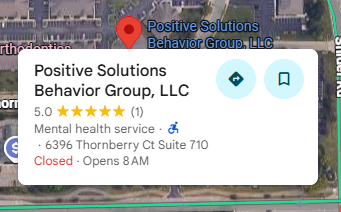ABA Therapy Demonstrates Measurable Progress in Schools
ABA Therapy fosters measurable academic, social, and behavioral progress in schools through structured interventions, positive reinforcement, and individualized support, enhancing communication, engagement, inclusivity, and classroom management for lasting student growth.
Mason, OH, United States, 24th Nov 2025 – ABA Therapy demonstrates measurable progress when integrated into educational settings, shaping a supportive environment where students can thrive academically and socially. Through structured behavioral interventions and individualized programs, ABA Therapy helps children enhance focus, communication, and adaptive skills. Schools that apply these methods often notice a steady improvement in student engagement and overall classroom harmony. The consistency of data-driven practices allows educators to monitor student growth effectively, ensuring that each child receives the guidance necessary for long-term development. By reinforcing positive behaviors and reducing disruptive patterns, ABA Therapy promotes inclusivity and helps teachers maintain balanced learning spaces. The measurable outcomes highlight its value as a practical approach for fostering progress across diverse educational communities.

Building Positive Learning Behaviors
ABA Therapy establishes a structured framework that helps students adopt positive behaviors in the classroom. Teachers use reinforcement techniques to encourage participation, focus, and cooperation among learners. Over time, this consistent approach fosters better classroom engagement and minimizes disruptions that hinder learning. By replacing challenging behaviors with constructive alternatives, educators can cultivate a respectful and motivating atmosphere. The result is a more productive environment where students feel empowered to learn, leading to sustainable academic progress and improved relationships among peers and teachers alike.

Strengthening Communication Skills
Through tailored interventions, ABA Therapy enhances verbal and non-verbal communication skills in school-aged children. Students learn to express their needs, share ideas, and engage meaningfully with teachers and classmates. Communication growth also supports social integration, allowing learners to participate more confidently in group settings. Educators apply structured prompts, repetition, and positive reinforcement to ensure lasting improvement. These methods not only bridge communication gaps but also foster emotional understanding.
Encouraging Expressive Language Development
ABA Therapy empowers students to articulate their thoughts and emotions clearly. By strengthening expressive language, children improve their ability to share ideas, seek help, and engage confidently in both classroom discussions and peer conversations, fostering stronger interpersonal connections and overall academic participation.
Improving Non-Verbal Communication Cues
Students learn to interpret and use gestures, facial expressions, and body language effectively through ABA Therapy. These non-verbal skills enhance understanding, empathy, and cooperation among peers. Improved non-verbal communication also supports emotional regulation, helping students navigate social interactions more successfully within school environments.
Enhancing Teacher-Student Interaction
Through consistent practice, ABA Therapy builds meaningful communication between teachers and students. Educators use structured prompts and reinforcement techniques to encourage clarity and active listening. This mutual understanding improves classroom dynamics, strengthens trust, and fosters a more responsive and inclusive learning atmosphere for all participants.
Fostering Peer Communication and Collaboration
ABA Therapy encourages teamwork and social exchange by guiding students in group interactions. Structured role-play and collaborative tasks help learners practice effective communication, share ideas respectfully, and resolve conflicts constructively. These experiences nurture confidence and cooperation, essential for successful peer relationships and classroom harmony.
Building Confidence Through Positive Reinforcement
Positive reinforcement plays a vital role in improving communication outcomes. With ABA Therapy, every successful interaction is celebrated, motivating students to communicate more frequently. This consistent encouragement strengthens self-esteem, supports emotional growth, and promotes long-term confidence in both verbal and non-verbal communication.
Promoting Academic Engagement
ABA Therapy plays a crucial role in boosting student engagement and participation in learning activities. Through individualized lesson reinforcement, students develop habits that improve attention span and task completion. Educators observe better classroom focus as learners adapt to structured routines. Reinforcement systems help maintain motivation, allowing students to take pride in their accomplishments. This targeted approach encourages persistence and reduces frustration associated with difficult subjects. Over time, academic engagement becomes more natural, supporting overall school performance and fostering a positive learning experience for students and educators alike.
Encouraging Social Interaction
Social growth is a fundamental aspect of ABA Therapy in educational environments. Through guided practice and peer-based exercises, students learn essential social behaviors such as sharing, turn-taking, and empathy. These interactions promote confidence and inclusivity in group settings. Educators utilize structured play, modeling, and reinforcement to nurture cooperative learning. Over time, children develop stronger social awareness and emotional regulation. The ability to form and maintain friendships becomes a source of motivation and happiness, contributing to a supportive school culture that values respect, kindness, and collaboration.
Enhancing Classroom Management
Teachers benefit greatly from ABA Therapy strategies that streamline classroom management. By introducing clear expectations and consistent reinforcement systems, educators can reduce behavioral challenges and maintain an organized learning environment. Positive behavior interventions create structure, predictability, and accountability among students. This clarity helps learners understand boundaries and expectations, minimizing disruptions that can interfere with teaching. As classrooms become more harmonious, teachers can devote greater attention to instruction and student development, resulting in improved overall academic outcomes and a more balanced educational setting.
Measuring Behavioral Progress
One of the strongest advantages of ABA Therapy lies in its focus on measurable outcomes. Educators and specialists collect data to assess how specific strategies influence student behavior and learning progress. This ongoing evaluation helps identify areas requiring additional support and allows timely adjustments. By using objective measurement tools, schools can ensure that each child benefits from a personalized and effective program.
Tracking Individual Student Growth
ABA Therapy emphasizes consistent monitoring to document each student’s behavioral and academic progress. Educators use structured observations and data collection methods to recognize improvement patterns, identify learning challenges early, and apply targeted interventions that enhance overall student performance and classroom participation.
Utilizing Data for Informed Decisions
Through precise data analysis, ABA Therapy enables educators to make informed instructional choices. Behavioral metrics guide necessary program adjustments, ensuring interventions remain effective. This data-driven approach strengthens accountability, improves classroom management, and supports continuous improvement tailored to each student’s unique developmental needs.
Identifying Areas Needing Support
Regular evaluation in ABA Therapy helps teachers and specialists pinpoint behaviors requiring additional attention. By addressing challenges early, educators can implement specialized strategies that promote emotional regulation, focus, and self-control, ensuring each student receives adequate support to sustain consistent behavioral growth.
Ensuring Consistency in Intervention
Consistency plays a vital role in the measurable success of ABA Therapy. By maintaining structured routines and reinforcement systems, educators ensure interventions are applied uniformly, allowing for accurate progress tracking and long-term stability in student learning and behavioral development.
Celebrating Achievements and Milestones
Recognizing progress is essential in ABA Therapy. Schools celebrate behavioral and academic milestones, reinforcing positive actions and motivating students to continue improving. These celebrations encourage confidence, build self-esteem, and validate the effectiveness of evidence-based strategies in fostering lasting developmental success..
Supporting Inclusive Education
ABA Therapy contributes significantly to inclusive education by ensuring that every student, regardless of ability level, receives meaningful learning opportunities. Structured interventions allow educators to address diverse needs while maintaining unity within the classroom. Students with varying learning styles benefit from individualized guidance that encourages participation and growth. By creating equal access to education, ABA Therapy promotes fairness, understanding, and collaboration among all learners. Inclusive practices not only enhance academic achievement but also nurture empathy, acceptance, and respect across the entire school community.
Conclusion
ABA Therapy continues to demonstrate measurable progress in schools by fostering meaningful improvements in learning, behavior, and social development. Through structured methods and individualized support, educators can help students achieve lasting growth in both academic and personal areas. The consistent results highlight the value of behavioral interventions in creating inclusive and effective educational environments where every learner can thrive.
For professional support and personalized care, reach out to Positive Solutions Behavior Group LLC, located at 6396 Thornberry Court, Suite 710, Mason, OH. Call 859-282-0400 to learn more about how ABA Therapy can enhance student success and classroom outcomes.
Positive Solutions Behavior Group LLC
6396 Thornberry Court, Suite 710, Mason, OH 45040
859-282-0400
https://positivesolutionsbehaviorgroup.com/
Company Details
Organization: Positive Solutions Behavior Group LLC (Mason)
Contact Person: Positive Solutions Behavior Group LLC (Mason)
Website: https://positivesolutionsbehaviorgroup.com/
Email: Send Email
Contact Number: +18592820400
Address: 6396 Thornberry Ct Suite 710, Mason, OH 45040
City: Mason
State: OH
Country: United States
Release Id: 24112537680

